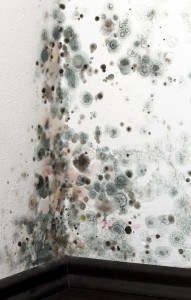Esther Tauscher stood outside her Staten Island home, leafing through boxes of family photos that had been steeped in storm water. She paused to point out life events – her honeymoon, holding her baby boy in a hospital bed.
The photos are just about all she has left. Behind her, the home where she and her family lived for 14 years was being dismantled by a masked volunteer crew that tossed out her possessions and ripped out floorboards and walls.
It was Tauscher’s only option. Her house and nearly everything in it was consumed by mold.
“If the water didn’t get it, the mold got it,” she said.
Three months after Superstorm Sandy, mold lurks in once-waterlogged buildings, hiding below subflooring, under foundations, and in door and window frames. Sometimes it mottles walls in plain sight. And it can make dwellers sick, another blow to people still recovering from the October storm that sent the Atlantic surging into homes in New Jersey and New York.
Mold is flourishing in homes that never completely dried out, where the owners may have waited to make repairs or could not access the house for weeks because of safety concerns. Other flooded homes remain vacant and unheated.
But even some who quickly chucked saturated belongings, ripped out soggy wallboards and carpets and scrubbed walls with cleaners and bleach are still finding mold, because the home didn’t fully dry, treatment did not work or unscrupulous contractors didn’t actually kill it.
“Mold needs two things. It needs food and it needs moisture,” said Paul Lioy, a professor of environmental medicine at Robert Wood Johnson Medical School in Piscataway, N.J. “So if you have places that aren’t completely dried out, you’re going to have conditions that are ripe for mold growth.”
Mold can spur coughing, wheezing and other reactions in people who are allergic or sensitive to it or have asthma, and can cause infections in people with chronic lung conditions.
In 2004, the Institute of Medicine found “sufficient evidence” of a link between damp, moldy indoor environments and upper respiratory tract symptoms, coughing and wheezing in healthy people, and asthma symptoms in asthmatics.
If mold is treated safely, there should be few long-term health effects, said Dr. Kevin Chatham-Stephens, a pediatrician and environmental health fellow at Mount Sinai Medical Center. But doing it yourself could make things worse. Chatham-Stephens said bleach and other chemicals used to clean mold can also cause respiratory irritation.
Mold remediation can cost as much as $15,000 and require people to leave their homes for days. It is not directly covered by the Federal Emergency Management Agency or New York City’s Rapid Repair program, which provides emergency repairs to residents affected by the storm.
New York Mayor Michael Bloomberg on Thursday announced a $15 million public-private partnership to remove mold in about 2,000 city homes. The money was raised privately, and the program will be run by a community development nonprofit. It will find homeowners through referrals, with the neediest families receiving priority. The city is also holding training sessions on how to deal with mold in the home.
The program was launched by the Mayor’s Fund to Advance New York City, the Red Cross and the Robin Hood Foundation.
Joseph McKellar, executive director of Queens Congregations United for Action, said that the city’s program is “a good first step,” but that 2,000 homes is “really only a start.”
McKellar and other labor, faith and community leaders formed “Back Home, Back to Work,” an organization that wants to use union members to clean out mold-infested homes in New York. The group is calling for part of the $50.5 billion emergency aid package passed by Congress to be used for mold remediation. Sen. Charles Schumer said he would like to see federal money allocated to fight mold.
New Jersey is looking at opportunities for a similar program, said Donna Leusner, a spokeswoman for the New Jersey Department of Health. The state is waiting to see if grants from the aid package can be used to help residents fight mold.
The Robin Hood Foundation also made grants to programs in New Jersey that provide free mold remediation to Sandy victims.
Lioy worries the mold problem will only get worse in the spring and summer, when consistently warm temperatures will allow mold to flourish. Even warm days like Wednesday and Thursday, when temperatures reached into the 50s and 60s, can accelerate mold growth.
Richard Schielke scrubbed the salt and mud off his hardwood floors after the storm but discovered weeks later that mold lurked under the floor. He hired a crew from Flag Enterprises, a Lindenhurst, N.Y., restoration services company. Workers scoured his moldy floor and walls and set up large air filters that hummed throughout his home.
“There was no playbook saying, ‘If this happens, this is what you should do,”‘ Schielke, of Massapequa, N.Y., said.
Alyssa Durnien, of Keansburg, N.J., came back to her damaged house about 15 days after the storm and sprayed a mildew product on the wood and underbelly of her home, which had mold damage.
Months later, the mold is back. Durnien set up dehumidifiers throughout the house and plans to hire a professional.
“I can tell you,” she said, “there’s still mold there.”
Was this article valuable?
Here are more articles you may enjoy.

 Johnson Controls Unit to Pay $750M to Settle ‘Forever Chemicals’ Lawsuit
Johnson Controls Unit to Pay $750M to Settle ‘Forever Chemicals’ Lawsuit  California Chiropractor Sentenced to 54 Years for $150M Workers’ Comp Scheme
California Chiropractor Sentenced to 54 Years for $150M Workers’ Comp Scheme  Dog-Related Injury Claim Payouts Hit $1.12B in 2023, Report Shows
Dog-Related Injury Claim Payouts Hit $1.12B in 2023, Report Shows  Travelers Survey: Distracted Drivers Making US Roads More Dangerous
Travelers Survey: Distracted Drivers Making US Roads More Dangerous 